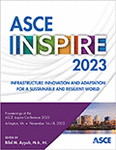Computational Modeling of Cured-in-Place Structural Liner for Aged Pipeline Rehabilitation
Publication: ASCE Inspire 2023
ABSTRACT
Pipeline infrastructure is crucial to help economic growth across the country. Pipelines are used to gather, transport, and distribute water, oil, or gas to end-use consumers. More than half of the pipelines in the US have been in service for more than 60 years. Cured-in-place pipe (CIPP) structural liner is a trenchless rehabilitation method to repair aged underground pipelines. Carbon fiber-reinforced polymer (CFRP) is a popular liner material used to rehabilitate and improve the service of pipelines. To investigate the effect of CFRP liner on pipeline maintenance and rehabilitation, we simulate the mechanical properties of CFRP liner for damaged pipeline rehabilitation through three-dimensional finite element analysis. A parametric study is conducted to demonstrate the effect of liner thickness and in-pipe pressure on the performance of the CFRP liner rehabilitation. The computational modeling results exhibit the relationship between liner thickness and rehabilitation effect, and the stress concentration location at the damaged area. The results of the paper can be applied for the optimal design of CIPP liner and enhanced sustainability and resilience of the US pipeline systems.
Get full access to this article
View all available purchase options and get full access to this chapter.
REFERENCES
Babuska, I., and Szabo, B. (1982). On the rates of convergence of the finite element method. International Journal for Numerical Methods in Engineering, 18(3), 323–341.
Baird, G. M., and Folkman, S. (2018). Benchmarking your break rates: A review of new findings and trends from North American water main break studies. Pipelines 2018: Condition Assessment, Construction, and Rehabilitation, 408–416.
Chuk, C., Urgessa, G., and Thippeswamy, H. (2011). Numerical analysis of stresses for cured-in-place-pipe linings. WIT Transactions on The Built Environment, 71, 283–293.
Cohen, B. R. (2012). Fixing America’s crumbling underground water infrastructure. Competitive Enterprise Institute, 6.
Fang, H., Yang, K., Li, B., He, H., and Xue, B. (2020). Parameter analysis of wall thickness of cured-in-place pipe linings for semistructured rehabilitation of concrete drainage pipe. Mathematical Problems in Engineering, 2020.
Hashemi, B., Iseley, T., and Raulston, J. (2011). Water pipeline renewal evaluation using AWWA class IV CIPP, pipe bursting, and open-cut. In ICPTT 2011: Sustainable Solutions For Water, Sewer, Gas, And Oil Pipelines (pp. 1257–1266).
Jeon, S.-S., O’Rourke, T. D., and Neravali, A. N. (2004). Repetitive loading effects on cast iron pipelines with cast-in-place pipe lining systems. Journal of Transportation Engineering, 130(6), 692–705.
Ji, H. W., Koo, D. D., and Kang, J.-H. (2020). Short-and long-term structural characterization of cured-in-place pipe liner with reinforced glass fiber material. International Journal of Environmental Research and Public Health, 17(6), 2073.
Lee, L. S., Estrada, H., and Baumert, M. (2010). Time-dependent reliability analysis of FRP rehabilitated pipes. Journal of Composites for Construction, 14(3), 272–279.
Lu, H., Behbahani, S., Azimi, M., Matthews, J. C., Han, S., and Iseley, T. (2020). Trenchless construction technologies for oil and gas pipelines: State-of-the-art review. Journal of Construction Engineering and Management, 146(6), 03120001.
Lu, H., Wu, X., Ni, H., Azimi, M., Yan, X., and Niu, Y. (2020). Stress analysis of urban gas pipeline repaired by inserted hose lining method. Composites Part B: Engineering, 183, 107657.
Matthews, J. C., and Allouche, E. N. (2012). Fully automated decision support system for assessing the suitability of trenchless technologies. Journal of Pipeline Systems Engineering and Practice, 3(2), 55–64.
Melchers, R. E. (2017). Post-perforation external corrosion of cast iron pressurised water mains. Corrosion Engineering, Science and Technology, 52(7), 541–546.
Minagata, H., Yoshizaki, K., and Hatsuda, Y. (2003). Risk assessment of gray cast iron pipelines. In New Pipeline Technologies, Security, and Safety (pp. 621–628).
Mokyr, J., and Strotz, R. H. (1998). The second industrial revolution, 1870-1914. Storia Dell’economia Mondiale, 21945(1).
Najafi, M., Gokhale, S., Calderón, D. R., and Ma, B. (2021). Trenchless technology: Pipeline and utility design, construction, and renewal. McGraw-Hill Education.
PHMSA. (2022). Cast and wrought iron inventory. https://www.phmsa.dot.gov/data-and-statistics/pipeline-replacement/cast-and-wrought-iron-inventory.
PHMSA. (2023). Pipeline replacement background. https://www.phmsa.dot.gov/data-and-statistics/pipeline-replacement/pipeline-replacement-background.
Tomczak, E., and Zielińska, A. (2017). Example of sewerage system rehabilitation using trenchless technology. Ecological Chemistry and Engineering S, 24(3), 405–416.
Vetter, C. P., Kuebel, L. A., Natarajan, D., and Mentzer, R. A. (2019). Review of failure trends in the US natural gas pipeline industry: An in-depth analysis of transmission and distribution system incidents. Journal of Loss Prevention in the Process Industries, 60, 317–333.
Wang, W., Zhou, A., Fu, G., Li, C.-Q., Robert, D., and Mahmoodian, M. (2017). Evaluation of stress intensity factor for cast iron pipes with sharp corrosion pits. Engineering Failure Analysis, 81, 254–269.
Information & Authors
Information
Published In
History
Published online: Nov 14, 2023
ASCE Technical Topics:
- Carbon fibers
- Computer models
- Construction engineering
- Construction methods
- Curing
- Engineering fundamentals
- Engineering materials (by type)
- Fiber reinforced polymer
- Fibers
- Infrastructure
- Linings
- Materials engineering
- Materials processing
- Models (by type)
- Pipeline systems
- Pipelines
- Polymer
- Rehabilitation
- Synthetic materials
Authors
Metrics & Citations
Metrics
Citations
Download citation
If you have the appropriate software installed, you can download article citation data to the citation manager of your choice. Simply select your manager software from the list below and click Download.
